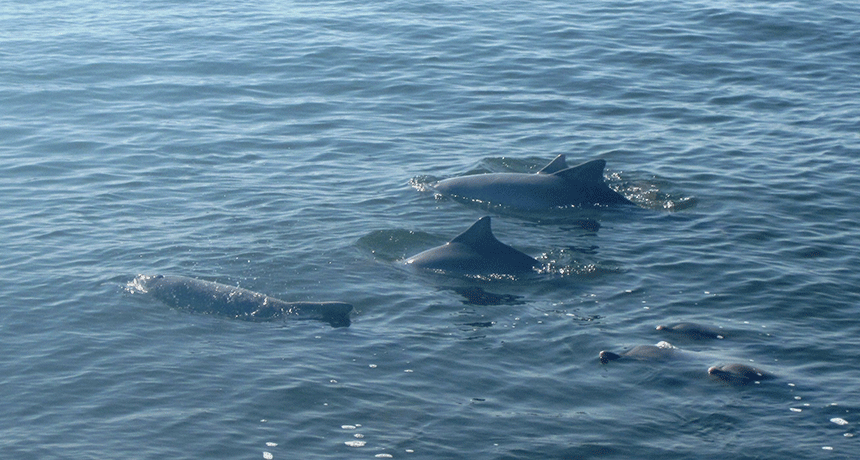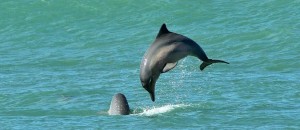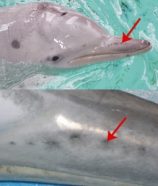Dolphin dimples detect electricity
Depressions in a dolphin’s snout sense electric fields, may help find dinner

Ícaro Gimenez/Wikimedia Commons
Share this:
- Share via email (Opens in new window) Email
- Click to share on Facebook (Opens in new window) Facebook
- Click to share on X (Opens in new window) X
- Click to share on Pinterest (Opens in new window) Pinterest
- Click to share on Reddit (Opens in new window) Reddit
- Share to Google Classroom (Opens in new window) Google Classroom
- Click to print (Opens in new window) Print

A person can use all five senses while spending time with dolphins. We can see them frolic in the waves, hear them call and splash, and feel their rubbery skin. We can sniff dolphins, though they don’t have much of an odor. And those willing to get close enough for a lick could find out what dolphins taste like.
Dolphins can sense you, too, but not in all the same ways. They have keen eyesight, for example, but no sense of smell. Sensory biologists try to understand connections between animal behavior and the senses. One team of these scientists recently made an unexpected discovery about certain dolphins.
The researchers found that Guiana dolphins detect electric fields, an ability that may help them find fish to eat. Scientists suspect these dolphins are benthic eaters, which means they look for fish food on the seafloor. Down there, animals stir up clouds of dirt while foraging, making it hard to see. Finding food with electric fields could come in handy in such murky waters.
The secret to this newly found sense, say the scientists, is hidden in the dolphins’ snouts.
“We were really surprised to find this in the dolphin. Nobody had expected it,” Wolf Hanke told Science News. Hanke led the new dolphin study and is a sensory biologist at Germany’s University of Rostock.

Living organisms generate electric fields. The beat of a heart, the work of a cell and the pump of gills all produce tiny but measurable electric fields. In 1992, scientists even measured the electric field produced by small goldfish.
“Everything that I’m doing when I’m talking, when my brain is working, is making an electrical field. And water carries electricity,” Paul Nachtigall told Science News. Nachtigall, who did not work on the new study, is a marine biologist at the University of Hawaii at Manoa. He says animals generate natural electric fields in many ways.
Hanke and his team suspected the dolphin’s electro-sense might have something to do with small dimples on the animal’s snout called vibrissal (pronounced “vy-BRIS-uhl”) crypts.
“We thought they must have some function,” Hanke told Science News.
To find out for certain, his team studied two Guiana dolphins from an aquarium in Münster, Germany.
Guiana dolphins look like smaller versions of the well-known bottlenosed dolphins. Found in shallow waters near the east coasts of Central and South America, Guiana dolphins’ choice of habitat has earned them the nickname “costeros.”
The scientists first studied tissue from the snout of a 29-year-old dolphin that had died of natural causes. Under a microscope, the vibrissal crypts looked familiar: They resembled the sensors used by other animals to detect electric fields. The scientists also found nerve fibers running into the pits — a sure sign of electrical activity.
Next, Hanke and his team tested a live dolphin, a 28-year-old named Paco, to see if he could recognize an electric field. They taught Paco to swim close to a device that could create a weak electric field in the water. Then the team taught Paco to swim away from the device (and toward a fishy treat) if he detected any changes in the electric field. When the scientists flipped the switch and created an electric field, Paco swam away — showing that he knew something had changed. When there was no field, Paco stayed put. When Paco’s snout was covered in plastic, he didn’t react to the electric field.
Paco’s behavior told the scientists that the dolphin used his snout to detect the tiny electric field.
Other scientists are excited by the finding. “This is a major breakthrough,” Peter Madsen told Science News. Madsen, who did not work on the study, studies the senses at Aarhus University in Denmark. “I think they’ve demonstrated in a convincing way that this dolphin species can use electro-reception, and in a way that’s sensitive enough to potentially detect prey.”
POWER WORDS
benthic Related to the animal and plant life found on the bottom of a body of water.
biology The study of living things.
marine Of, found in, or produced by the sea.
sensory Of or related to the physical senses, such as touch, sight and sound.
organism An individual life-form.
electric field The electric field is the space where one charged particle can make another move closer or farther away. Charged objects, which have charged particles on the surface, can also make other charged objects move.







